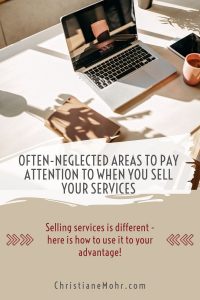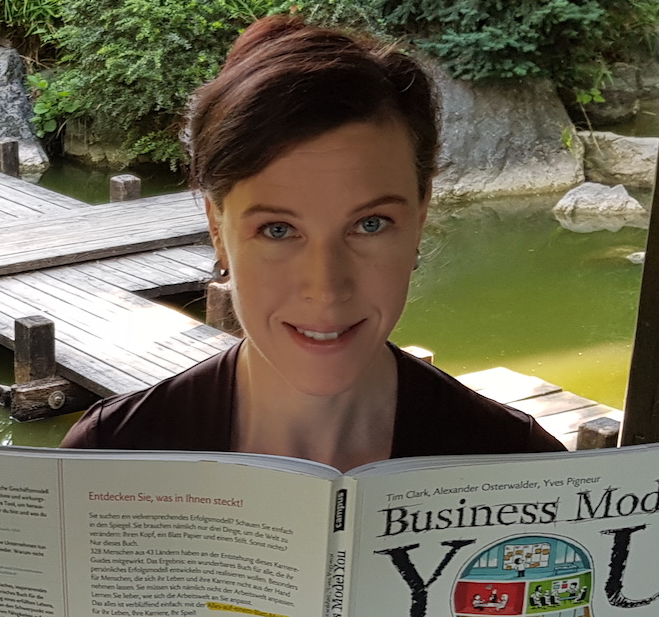Services can’t be judged like normal products. They can’t be touched or tested, there are no physical attributes, that give away the quality, no pricey looking packaging, that promises a high quality. Plus, a service can’t be taken back for refund of your money.
Sounds like common sense, right? Unfortunately, most of the time neither the client nor the service provider is fully aware of this aspect.
 “Don‘t worry, this is not a big thing, we will go in at only three spots and remove parts of this hip bone here… “
“Don‘t worry, this is not a big thing, we will go in at only three spots and remove parts of this hip bone here… “
Really? I’m pretty certain he must have read the utter disbelief in my eyes.
Rewind a few weeks.
Whilst running my usual tour I suddenly had a stabbing pain in my right groin, my first impulse: „it‘ll go away – just go a bit easy for a few minutes“
Turned out it was not as easy… a few days later I was still limping and in pain, so I went to my physio. But after three sessions not a lot had changed, so he recommended I go to an orthopedist.
I started asking around and got a recommendation and made an appointment.
And then the tragedy unraveled. Stepping into an empty waiting room I was pretty certain not to have to wait for too long.
Then a young man arrived, sporting a pair of jeans and a somehow derelict white t-shirt.
I honestly thought he was a delivery guy and getting whatever to take it to wherever.
But he said hello and told me that it would take a bit longer – okayyyy I thought. I hope he’s older than he looks.
Next thing a guy looking like out of a gangster movie with his girlfriend is entering the room.
Young doctor comes over and they are doing the whole gang style fist bump hand thing just before hugging (whilst I was sitting sweating on a hot day under my face mask looking right at a big “mind your distance sign”).
My happiness level dropped even more. Then he called them in the surgery and I waited longer.
Finally, after quite a long wait but short examination and very few questions he told me he needed to do an X-ray and I acquiesced. Looking at the x-ray, he told me that this was a birth defect and that I needed surgery….
Fortunately, my exit from that practice was a lot faster than my entry time.
Why selling services is different – the specific problems of personal services
So, as a health coach there are a lot of elements that you need to pay attention to and that are a placeholder for the quality of your service.
And when services are sold online or via phone the details are even more important.
People are paying attention to tangible elements even if these don‘t have anything to do with the service you are providing.
Services can’t be judged like normal products. They can’t be touched or tested, there are no physical attributes, that give away the quality, no pricey looking packaging, that promises a high quality. Plus, a service can’t be taken back for refund of your money.
Sounds like common sense, right? Unfortunately, most of the time neither the client nor the service provider is fully aware of this aspect.
As a client we think we just have a “bad gut feeling” about the service provider. But this is our buyer’s psychology at work. For lack of tangible elements, we use intangible elements to tell us more about the product – being the person that delivers the service and the service itself.
Why you need to understand the dichotomy of client behavior
You are not the client, but you are the client. At university we were always told: Do not make assumptions based on what your preferences are. And whilst this is right, this is also wrong.
It is right, because if your ideal client is not even close in personality, dreams and values to the person you are, putting your preferences to the forefront won’t work. If she is, cut loose, she will be happy to find someone just like her, that can help her with topic xyz.
But if she is not, you have to see everything though her eyes and base your decisions on her preferences and wishes. And while this is not the topic of today’s article, this is why you need to know your ideal client intimately and pick your niche. Because it is absolutely impossible to cater to everyone and still be seen as the go to person…
But it is also wrong as there are basic human behaviors. Our brains work pretty much the same. We decide on an emotional basis and then afterwards our brain finds reasons, why our gut decision was the right one.
In marketing there is a term called buyer’s remorse. It coins the time frame shortly after buying or making a buying decision, when a client thinks his decision might have been wrong. The client is searching for reasons that support the decision, but is also all to open to negative aspects to give them an out.
Areas your clients use to put a quality assumption on your work as a coach
Here are the main areas potential clients pay attention to (consciously or unconsciously) when trying to evaluate the quality of a service and if the service provider is trustworthy.
So, go check and if necessary, improve these areas to pass the quality assumption test of your potential clients.
Your practice, video consults
Looking at the surroundings tells us a lot. Even more when being in a semi-private surrounding. Your practice will bring them to assumptions about how structured and organized you are.
Does it look like it is your place of work or a random room that is used by the whole family?
Is your practice a mess or spotless and super organized?
Do you give your client the feeling of being welcome, prepared and is the atmosphere one that lets them open up and allows change to happen (especially important for life coaches)?
Pay attention to the light, smell, sounds, maybe even how the floor feels and if a carpet might make a difference. Do you have flowers and some color to brighten the atmosphere, especially on grey days?
I think you get the gist. Put yourself in the shoes of your ideal client and check how you could improve the room where you receive your clients.
Now with COVID and the “work from anywhere” movement many service providers switched to video consults. I’m not an expert by any means, but many of the things I said above apply. Only on a smaller scale, as the part of your work area that the client sees, is minimal.
Still try to keep that area really clean, curate your background with a plant, something personal, that might also act as a conversation starter, some books etc.
Make the experience as personal as possible!
Your work ethic, your behavior towards your clients and prospects
This is how trustworthy and professional you will come across.
When a client leaves a message, how long does it take you to call back. If the message is not asking you to call back, but gives an update – do you care to call back or send a sort message thanking her for the update?
Are you keeping deadlines when handing over therapy plans, how long do they have to wait and how structured and personal does it look?
There is a plethora of things that define how others see you, we will have a look into the most common ones:
Your correspondence: email, telephone, apps
How professional looking is your correspondence?
Pay attention to grammar and punctuation. Depending on your ideal client, being negligent in your written communication turns them away, especially if they are new.
Also, make sure that what you write is clearly understandable. If you are working with non-native speakers this is extremely important. You might not be aware of how easy it is to get confused by a complex sentence structure. People are then filling in the blanks, but this might not get them – and thus you – the result that you’re aiming for.
When looking at your email communication: Did you already streamline it?
Telephone
When you’re not available, can your clients and prospects leave a message and get a call back within a rather short timeframe? Set up a welcoming and clear message, also communicating clearly if you’re not available for a certain time.
Apps
When using mobile apps on your smart phone, you should understand that certain GDPR rules might apply for Europe and CCPA in California. If you are working with any customer located in the EEA (basically whole Europe), you need the consent of your client to share their information with the service you are using (please don’t shoot the messenger, I know that all our information has been shared umpteen times, but the fines in this area can be hefty). Keep your eyes open for the next article, one of the interviews during The Health Coaching BizSHIFT summit was about GDPR).
As I’m pretty certain you don’t want to get and document that consent, I recommend to choose the option to not share your contact data with that app (which is the easy way out, but you then can’t find contacts automatically and get notifications when a friend of you joins – our ease of use is paid with personal data, which is no longer only our decision for personal data that belongs to our clients. This applies basically to all of the messaging apps; most offer the bespoke setting after nearly 4 years of GDPR.
This brings us to another point that I don’t want to deep dive into today. You need to be aware of where you’re keeping and how you are handling personal data. Make yourself familiar with GDPR and have at least a basic documentation of what you’re doing with your clients’ personal data.
What’s your physical representation?
Your clothing, your hair and just in general how fresh and healthy you look, makes an impression on your clients. I remember not trusting and dropping health coaches because I didn’t have the feeling that they were living the lifestyle that they were promoting. How would I learn from someone looking unhealthy how to have a healthy lifestyle?
Being authentic in your work and your actions is really important.
As a sidenote: In some countries there might even be rules about what you can or cannot do as a health coach. In Germany for example, you can’t have a picture of yourself with a white coat and stethoscope on any communication, as it implies that you are a medical doctor (read a longer article on this here (German)). In your country the rules might be different. The important thing is you have to be aware of the rules that apply to your profession.
Your Website
In the days of Internet and remote communication your website is basically your storefront window, so make sure, that it is inviting. It has to be easily handled, and your services and special skills need to be clear and easy to find.
If you’re not a structured person, get help with defining the structure of your website. People want to find what they are looking for fast. It also needs to directly speak to them – how will your service make their day better.
Many coaches are afraid of the technical part of their website. But this is actually the easy part that also can be handed over to someone else.
After this is done and your website is ready to go live, before you push publish on your website, test all pages and links and especially your contact form.
Presenting yourself and your services on social media
On social media it is easy to get carried away and forget that you are rather broadcasting then having a written conversation (unless you are using DM). Always keep in mind that you show your dedication to quality and thoroughness but also your personality in every post you share.
- Show your quality by well structuring your profile and by putting the emphasis on relevant information.
- Make it easy for your visitors to understand what you are offering and offer valuable content, not a mediocre fast-fluff throw together post.
- Also stay on track with your message and purpose.
- Yes, it might be nice to post something that you found entertaining, but think of it like the super sweet indulgence you are recommending to have only once in a while.
- And be consistent – this is less about how people perceive you but about building momentum.
I also recommend to create and use templates, which will make it faster and easier for you, but it will also keep the appearance of your posts tidy and well recognizable.
It is also important that you have a recognizable look across all platforms and that your message is clear and won’t confuse people seeing you on more than one platform.
Note: every platform has different rules and on some, text works better than pictures. The most important thing is to understand that you also communicate with the form, not only with the content.
At the end of the article, I created a short next steps list for you to get you started. I know this can be quite some work when looking at every area. This is why I want to encourage you to schedule these tasks into your calendar over the next two or three weeks or tackle just the ones, where you know you have room for improvement.
I hope that this article inspired you to improve some little things that might have a big impact.
Let me know, which part you would like to get more information on.
Keep moving

YOUR NEXT STEPS
- Check your work space with open eyes and find at least 3 things you can improve.
- Check your answering machine and improve your message if need be.
- Set up email templates for your 3 most common tasks.
- Check the “share contacts” status of the apps you use with your clients.
- Check your website: Do you think it’s an inviting storefront or does it need to be updated?
- Check your social profiles and make sure your communication is consistent.
- Create templates for your posts.
About The Author

Christiane Mohr
Hey there! I’m Christiane. Marketing Expert with an actual Masters in Marketing. Obsessed with helping health & personal development coaches. Also dedicated to running & finding the best cheesecake in town.
And I have a secret…
It’s not about how many Facebook followers you have but how you talk about your offers and who you’re the right fit for.
I help health & personal development coaches to build an ethically rooted & profitable business by defining their niche and their stand-out offer that they love to talk about (and fearlessly).
Here’s your roadmap to nailing your niche and attracting your dream clients with ease!
Want to stand out with a clear and enticing statement about who you help and what you do for them?
Want to stand out with a clear and enticing statement about who you help and what you do for them?
Snag my checklist-style workbook to ponder on the right questions so you can confidently choose your niche and create success in your health coaching business!
“This process helped me finally let go of wanting to help everybody with anything and aligned my business to myself.” – Daniela Pade
In case you only want the checklist but no additional tips, updates on new articles or special offers, please head over to the contact form and chose “Request for Checklist”.






